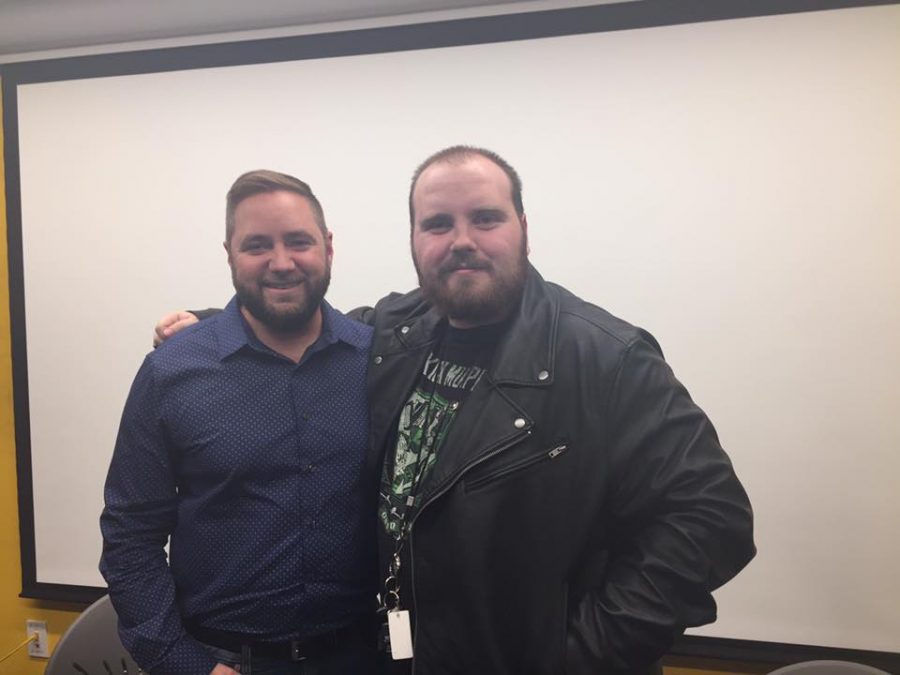Inside the ‘Blair Witch Project’ with Michael Williams
Seventeen years after the original Blair Witch Project was released, Actor Michael Williams sat down with the Film Appreciation Program of Pace to watch the horror film and share his experience working on its set last Friday night in Alumni Hall classroom.
Williams, along with Heather Donahue and Joshua Leonard, were cast out of around 1,000 people after an open call from Backstage Magazine. Williams said he had more freedom acting in Blair Witch than anything else he’s been in.
“It’s almost incomparable [to anything else] with the amount of freedom we had,” the actor said. “I think that’s why they really took their time casting it because they basically wanted to cast the people who were going to be the people. The only note they gave me was ‘be a more fearful’ version of yourself.”
The entire filming of Blair Witch was improvised, according to Williams. In order to create the most genuine acting possible, the actors tried to always stay in character.
“The whole thing was like method filmmaking,” Williams said. “We camped out there, we slept out there, we tried to stay in character as much as humanly possible. We ate less and less, we slept less and less. You’re staying in character so your job is to imagine that these things are terrorizing you in the woods if you continue to believe in that it can really tire you out.”
Despite this, Williams said that actors did break character on occasion so they could better communicate with each other.
“We had a code word, which we found out later when we got hungry was a bad one, it was called ‘taco,’” Williams said. “Originally when we went [to film] we were like, ‘We’re going to be in character and that’s it.’ But within a day it wasn’t working for me because I want to be able to trust my other actors, if we never had a, ‘Hey you okay?’ kind of moment as an actor it wouldn’t work.”
Williams said that the most powerful scene was Donahue’s monologue towards the end of the film where she has a breakdown and apologizes for creating the project.
“[Donahue] had to be so powerful to have us continually running the camera, and show this vulnerability. She got labeled as a bitch a lot, and I think that’s our fault as a society,” Williams said. “That confessional scene to me is award worthy, I don’t know if I’ve ever seen an actor or actress that raw in my professional life.”
The background actors in the film—like the fishermen—were a mix of actors and regular townspeople, and the main cast was not told which were which, according to Williams.
“The only reason I knew the fishermen were fake is because the current [in the river] was flying by and they were casting like [it was a calm],” Williams said.
In order to make the audience believe the film was real, after the film was released the actors faked their own deaths and went into hiding.
“They put us as deceased on IMDB, the internet was very young, it was like back in the day when newspapers came out. You believed anything you read,” the actor said. “[Viewers] thought we were in a snuff film.”
Once the actors revealed themselves to be alive they appeared on the covers of Newsweek and Time Magazine. Williams had mixed feelings about his newfound fame.
“Once they said, ‘the jig is up, it’s a movie,’ we still didn’t make any money,” he said. “So I was working for a local moving company, I would come off the truck, walk into a deli and my face would be on a magazine. And all the guys would be like, ‘What the hell man, yo check this out,’ and I would be like, ‘Yea that’s me, I don’t know what’s happening with my life.’ It was confusing honestly.”
Williams would go on to have roles in television series and movies such as Law & Order, The Objective, and Without a Trace. He encouraged anyone wanting to be an actor to form relationships and show kindness to others.
“Just hustle, get to know people, work hard, look people in the eye and be kind. Don’t complain and you will go far. It is very difficult if you’re an asshole,” Williams said.
Your donation supports independent, student-run journalism at Pace University. Support the Pace Chronicle to help cover publishing costs.

